Active Mind, Creative Spirit
Mother’s Day Climb
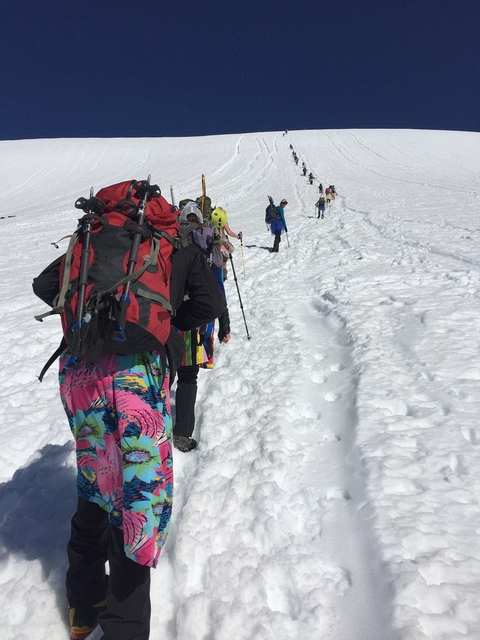
“Does this glissade chute make my butt look big?”
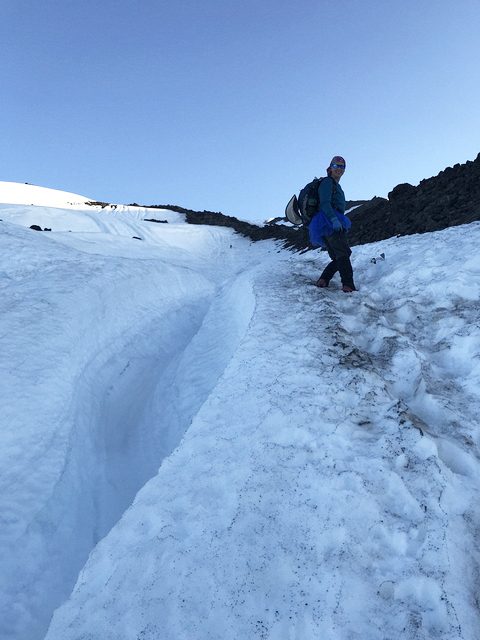
It’s been a long time since I climbed over 5000 vertical feet in a day. This year, for Mother’s Day, my family allowed me to escape the city, and spend the day with 5 other moms, and 495 other climbers, working up the side of Mt St Helens to its summit. In case you ever decide to do such a thing, here’s what it might look like.
You wake at 2:30 am, scarf down oatmeal, and begin from a packed parking lot at 4 am. If you’re lucky, one of your climbing partners, who is clearly more together than you are, passes out matching tutus so you can climb as a united force. Before dawn you’re above the tree line and slipping on snow, so you don microspikes (lovely inventions, they’re metal mini grippers for the bottoms of your shoes – not nearly as serious or dangerous as crampons). Soon even the brush and bushes are gone, and you’re out on a boulder slope scrambling in the near-dawn light.
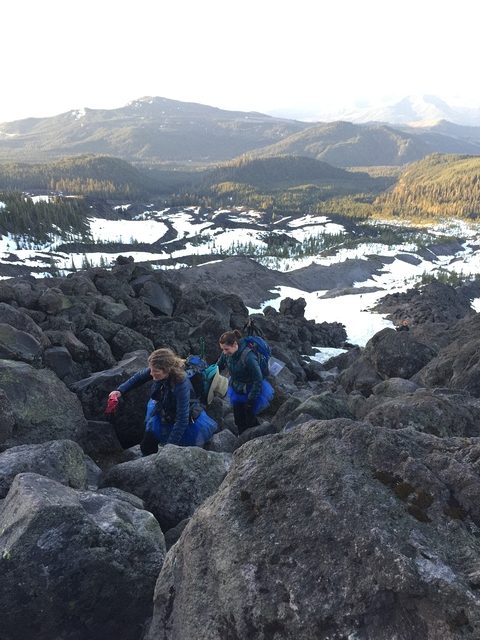
You’re using hands and feet, clinking with each step over rough volcanic rocks, that shred your gloves. In the descent of the boulder field, you wonder if you should have gone to the effort to pull off those spiky-feet, but wrestle through instead. Then begins an endless, repeating cadence of snowy ladder steps. Imagine your favorite, rugged set of stairs, covered in slushy snow. No hand railing.
Headlamps make way for sunglasses, hats and ice axes. One of the early pitches on Mt St Helens is the most vertical, so you don’t look up it, because if you do, you probably won’t climb it. Just step in the footprints of the person who went before you. Breathe. Don’t look down either. No ropes and your friend catches snow in her lap when your foot slips in the soft snow.

Over the next hour, the sun crests the east ridge, Mt Adams rises out of the hazy dawn, and the crunchy snow turns softer, and gives way more frequently under your feet. Two more hours and you’re in your head, counting steps and breathing. Air is noticeably thinner for those of us who reside at sea level. You tell yourself you’ll stop and rest at the next rock outcrop, but as the next ridge comes into view, you don’t stop.
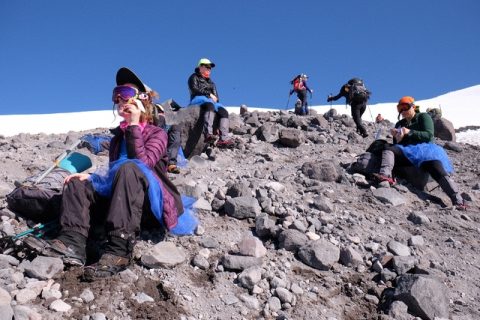
Once you stop, it’s hell to start again. You have to squeeze all that oxygen back into your muscles once they’ve relaxed, and that’s harder that keeping your burning thighs going. Just. Don’t. Stop. You push to the next outcrop of boulders and pumice dust. You hope you remembered to pee below the tree line, because there’s no place to do that up here! You’re 4 hours in. Most marathon runners would be finishing their runs now, but you’re just about to get to the good stuff. You accordion with your climbing mates. Some are ahead, some are below. You match up at rest spots to eat, sunscreen and change gear, then move on at your own pace.You have second breakfast and then bite in again. Step, step, breath. The air thins. Step, step breath. Then step, breath, step breath. It’s weird work; you’re telling yourself to go fast enough to make progress, but slow enough for your lungs to keep up. If you never hit a rhythm, you never get over the burn.
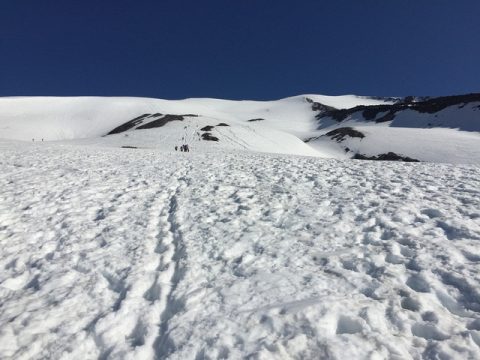
Deepest blue sky, sunscreen, serious eyewear. You finish one pitch only to realize what you thought was the top isn’t. There are more snowy ridges and ripples above it, and once you crest those, there will be more above them. You’re staring at a white, reflective mountainside, telling yourself stories, and feeling like “the bear went over the mountain.” You sing it to yourself a couple times to take your mind off the burning in your thighs and lungs. Lunch at 9:30 am. If you’re lucky, only a little bit of volcanic dust has blown into your teeth and crunches with your sandwich.
Occasionally the steps you’re following disperse and the snowfield becomes ragged, slushy and chaotic. Like running up sand hills. “I hate when the steps run out!” You moan playfully, and the guy behind you agrees loudly. The aire is friendly and light and fun. You’re all pulling for each other. But you’ll have to kick your own steps; an exhausting prospect. Your eyes search frantically for the best-made steps in white sea of chaos, and you side-step until you can get in them. The guy behind you is happy you’re kicking steps, saving him the work, but eventually you have to step out of the path and stand, panting on the slope to recover. He passes you. Several others do too. One of them pushes through a step and stumbles to get footing. She’s gasping right next to you, gasping next to her.
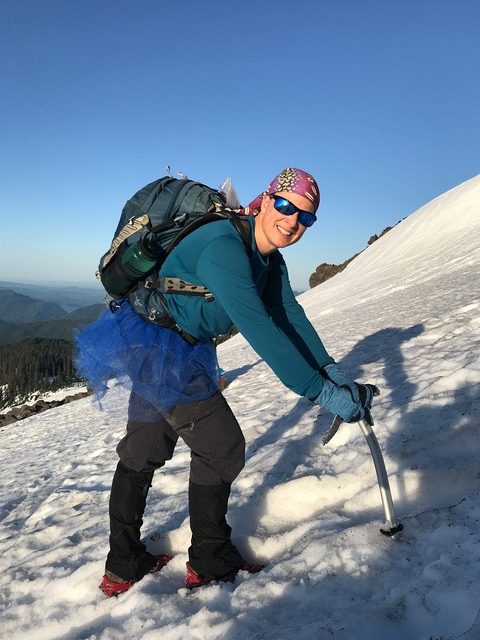
It’s a good opportunity to check the view. Mt Hood has been at your back all morning. It climbed out of the darkness while you were climbing the boulder field. The sun is peeling down the ridges on your left, revealing valleys and chutes that yesterday’s climbers rode down from the summit. Mt Adams is silhouetted by the rising sun, and up ahead there are miles of white. You begin again. It burns until your breath and legs match pace.
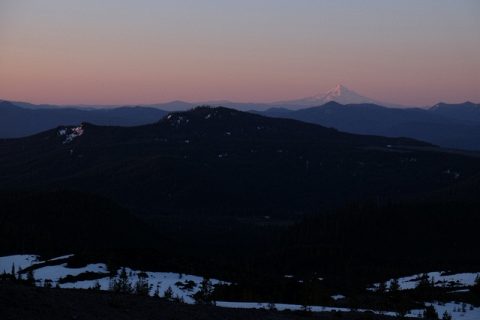
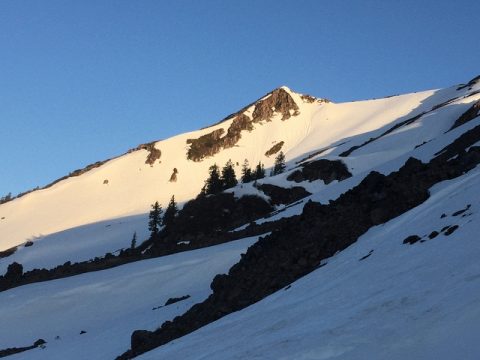
Climbers multiply, and soon you’re in a conga line, waiting for the guy ahead of you to take steps so you can take your own, filling the footstep he just left. You banter with him and compliment the house dress he’s wearing. It has poppies on it. He gives you genuine gratitude in return. The next guy up is in sequins.

Someone behind you in the line plays Sting, and you all sing “doo-doo-doo, daa-daa-daa” as a distraction. It’s a good climbing song; it moves your feet. You chuckle at the spectacle: burly men in dresses, women in blinking tutus with skis on their backs and the descent is on your mind. The last snowy slopes come into view. Breathe, step, step. Breathe. Your climbing mate encourages you back into the footsteps one last time. Then you look up and the party appears… a hundred fellow climbers are at the summit above you. Beer, dance party, wine spritzers… it’s a young crowd.
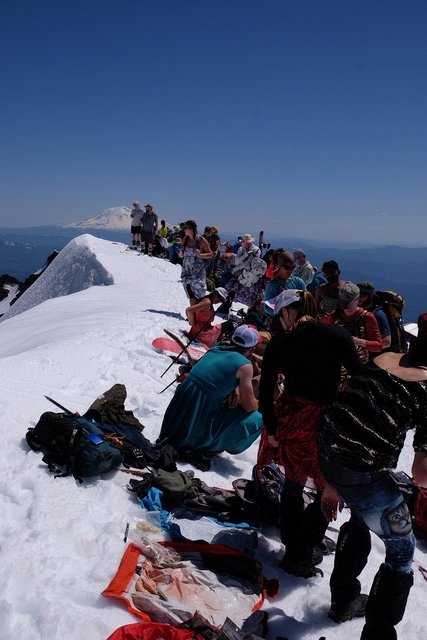
A male film crew is documenting the history of The Mother’s Day climb on MSH. They’re in red lamé floor-length dresses, wielding a full sized boom mic and TV camera, having climbed up in ski boots.
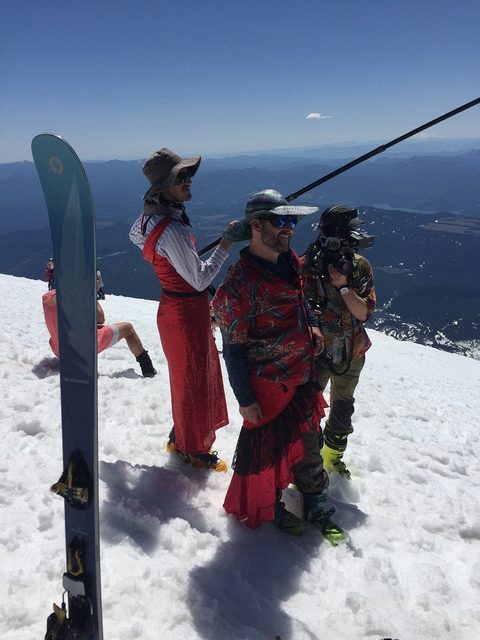
You puff and will your legs past the hordes up the slope to what you hope will be a flat summit area. There is none. The slope ends where the volcano crater begins.Tiny pink flags mark the edge of the crater beneath the snow. The rest of the snow is a cornice – an overhang of snow that reaches out beyond the edge of the crater. Despite all the warnings – the rangers in the parking lot, the info boards at the trail head, and all the things you could possibly read online – one skier slides across the entire length of the cornice, until a woman climbers yells him down.
“Oh, there’s a cornice here?” There’s always one guy. It’s him today. People have died up here that way. Let’s not make Mother’s Day memorable like that. You wag your head and nod at the yeller. Still, other people push the line – it’s so tempting to step one more step so you can see in the crater. Need to see in the crater. You hold your camera as far above your head as possible, so you can snap it over the ridge, but the sun is so high, and the snow is so bright, that you have no idea if you got it or not.
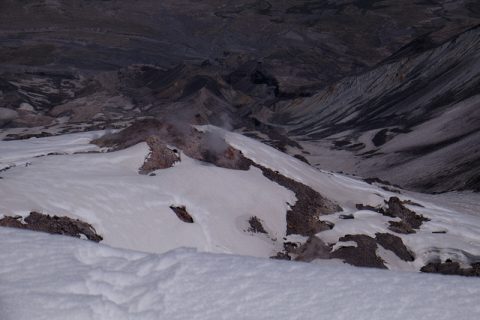
There are probably 200 of you up on the summit now. For every twenty or so that arrive off the conga line, only one or two leave it on skis or in glissade chutes.
There is much revelry and many dresses on outdoor-style mountain men. You watch them parade across the front of the crowd with pride. You can’t help but yell out, “Dude, you are rocking that neckline!” to which all the ladies in earshot laugh. He turns and smiles with a nod of satisfaction.
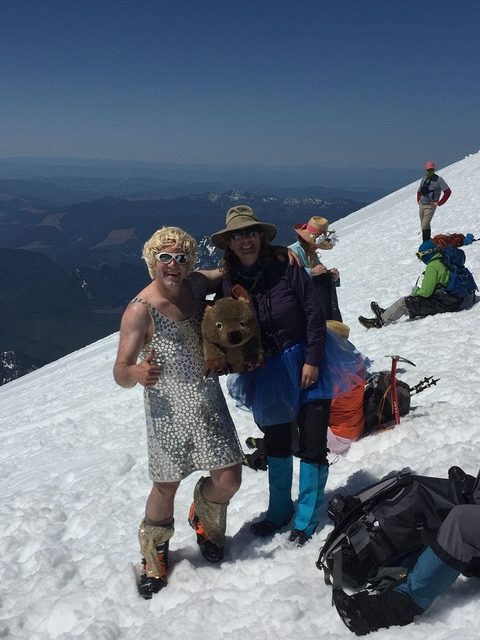

You pour a celebratory drink with our climbing partners, and watch the antics for an hour. The spectacle is amazing, but the view is so much better. Mt Rainier hangs above the crater to the north, and nearer, Spirit Lake, looking blue and beautiful. Mt Adams is to the east, Mount Hood to the south, and directly below you, a steaming crater that you can see into when you stand on your toes at the pink flags.
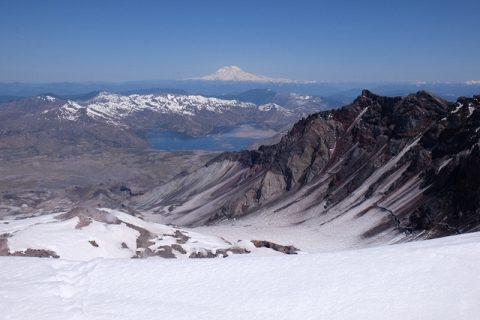

It’s time to go down after an hour and a half on the summit. Thankfully your legs don’t do most of the work. You don a giant trash bag, poking holes for your legs and sitting in it like a giant diaper, then you grab your ice axe and slip into a glissade chute and slide 4000 vertical feet down over the next hour. It’s like a water slide, but with snow walls. Or like the luge, but without a sled. Just keep that ice axe handy and steer with your feet. Rooster tails of snow fly over your boots, into your lap. Snow follows you down the chute, hissing long after you’ve passed. At times you’re a tiny avalanche all of your own making. When one chute ends, you bail out and find another one. You’re careful not to take one if you can’t see where it goes. There are rocks and drop offs. When in doubt, you send your fearless climbing partner down before you. She survives, emerging far below, so you follow. Snow in your lap, snow in your pants, snow in your hair. You squeal down the steepest ones, or scoot and struggle to keep moving down the shallow ones, and relax for the whole ride on several that are just right.
Then they end and you’re standing on dirty snow 4000 feet below the summit. An hour has passed. Maybe two, because you moseyed, and you still have three miles to walk out. You’re on your last sip of water. It’s a long three miles. Treeline, shade, slush, dirt, car. At the end you’ve gone up and down 5800 vertical feet, over 12 miles, and according to one fitbit: 27,000 steps, which doesn’t count the glissading (because it’s not steps). Twelve hours from trail head to trail head. Will you do it again tomorrow? Hell no. But you’ll probably do it again.
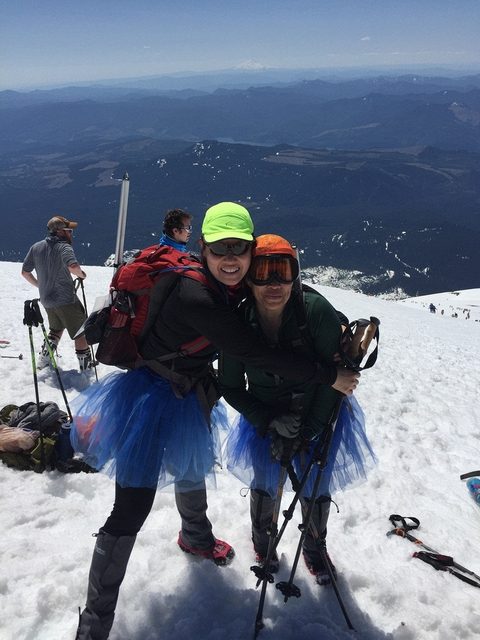
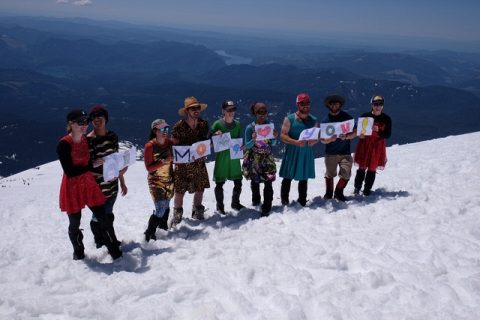
Pingback: Canyons on Wheels - From My 'Art